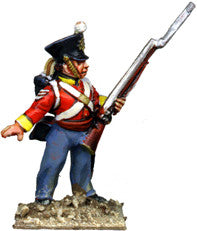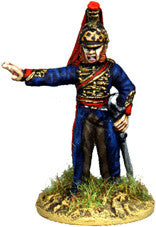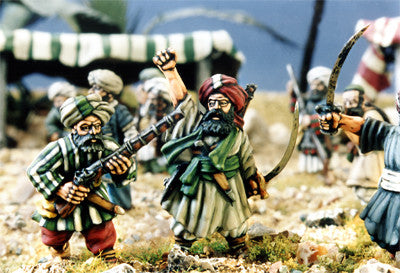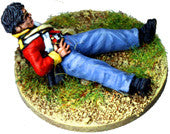1st Afghan War and the Siege of Jellalabad
by John French
 During the 1830’s Britain became fearful of Russian involvement in Afghanistan that could ultimately lead to the invasion of India. The British Government decided to send troops to Afghanistan to oust the Amir Dost Mohammed Khan and replace him with their own man Shah Suja. He was the former ruler who had been in exile since 1810, and had been decidedly unpopular with his subjects. Not surprisingly the population resented both the installation of Shah Suja, and the occupation of the country by British and Indian troops that were to keep him in power.
During the 1830’s Britain became fearful of Russian involvement in Afghanistan that could ultimately lead to the invasion of India. The British Government decided to send troops to Afghanistan to oust the Amir Dost Mohammed Khan and replace him with their own man Shah Suja. He was the former ruler who had been in exile since 1810, and had been decidedly unpopular with his subjects. Not surprisingly the population resented both the installation of Shah Suja, and the occupation of the country by British and Indian troops that were to keep him in power.
 The invasion force became known as the “Army of the Indus." It set out in December 1838. The army comprised elements of the Honourable East India Company’s Bombay and Bengal divisions, a few Queen’s Regiments (Regular British Army), 6,000 of Shah Suja’s levies (two regiments of cavalry and four of infantry) together with 38,000 camp followers and 30,000 camels.
The invasion force became known as the “Army of the Indus." It set out in December 1838. The army comprised elements of the Honourable East India Company’s Bombay and Bengal divisions, a few Queen’s Regiments (Regular British Army), 6,000 of Shah Suja’s levies (two regiments of cavalry and four of infantry) together with 38,000 camp followers and 30,000 camels.
The Bengal forces were commanded by Sir Willoughby Cotton. They included a cavalry brigade and 5 infantry brigades. Troops included the British 16th Lancers and 13th Foot, a regiment of Bengal European Infantry, two regiments of light cavalry, two of irregular light cavalry, and seven of Bengal Native Infantry. A troop of Bengal Horse Artillery and two companies of Foot Artillery (all European) and two companies of sappers and miners (all Indian troops) completed the Bengal division. Other troops were to supplement these forces at a later date.
The Bombay troops numbered around 3,500, they went by sea to Kurrachee (Karachi) from where they marched to Shikapur to join with the Bengal troops. They comprised the British 4th Light Dragoons, H.M. 2nd and 17th Regiments of Foot, one regiment of light cavalry and one of irregular cavalry. Two troops of horse and two companies of foot artillery (all European) accompanied them, along with four regiments of native infantry and one company of sappers and miners.
Click here for our guide to British Uniforms of the 1st Afghan War by John French
Afghan costume/dress:
 As the Afghans had no regular army, men fought in everyday clothing. References are often made to the use of white clothing. Many contemporary illustrations and photographs of slightly later periods show a variety of hues and shades. Angarkas (loose smock-like tunics) reached to mid-thigh or knees and is often depicted in striped material. Sashes or lungis were worn around waist or over shoulders and again often shown with stripes or bands of colour. Turbans, usually a sash wound around a kullah (a pointed skull cap) again were multi-coloured. Supposedly the more important the person, the more colours and decorations were used. Armour was used by a few, probably of Persian and Indian influence. Many men carried small dahl shields, round, of metal or covered in embossed leather. Poshteens, Afghan coats, were worn in cold weather.
As the Afghans had no regular army, men fought in everyday clothing. References are often made to the use of white clothing. Many contemporary illustrations and photographs of slightly later periods show a variety of hues and shades. Angarkas (loose smock-like tunics) reached to mid-thigh or knees and is often depicted in striped material. Sashes or lungis were worn around waist or over shoulders and again often shown with stripes or bands of colour. Turbans, usually a sash wound around a kullah (a pointed skull cap) again were multi-coloured. Supposedly the more important the person, the more colours and decorations were used. Armour was used by a few, probably of Persian and Indian influence. Many men carried small dahl shields, round, of metal or covered in embossed leather. Poshteens, Afghan coats, were worn in cold weather.
Siege of Jellalabad (Jalalabad), 11 March to 18 April 1842.
Following the defeat of the British army retreating from Kabul, Akbar Khan went on to besiege Jellalabad with some 6,000 men. As at Kabul, Akbar Khan offered safe conduct if the garrison returned to India. Unlike Kabul, the offer was refused as there were some 300 sick and wounded, the draught animals were deemed insufficient to carry the baggage and he estimated there to be 30 to 40 thousand hostile tribesmen in the surrounding areas. Sale also knew that a relief force under Major-General Pollock was on the way, even if it seemed to be taking an over-long time in arriving.
In an attempt to relieve the blockade Sale led out his men in three attacking columns. The Afghan right flank rested on a fort, whilst the left rested on the Kabul River. To the front were recently repaired walls from which marksmen fired on the advancing columns. Sale’s dispatch of 7th April stated
“The attack was led by the skirmishers and column under Captain Havelock, which drove the enemy in the most satisfactory manner from the extreme left of his advanced line of works, which it pierced at once, and proceeded to advance into the plain ; whilst the central column directed its efforts against a square fort, the defence of which was obstinately maintained.... The rear of this work having been gained by passing to its left, I gave orders for a combined attack upon the enemy’s camp... The artillery advanced at the gallop, and directed a heavy fire on the Affghan (sic.) centre, whilst two of the columns of infantry penetrated his line at the same point, and the third drove his left back from its support on the river....”
 Despite coming under counter attack from large bodies of horse and being under artillery fire from 3 guns screened by a garden wall the Afghan army was defeated. Their camp was captured and 4 guns were retaken which had been lost previously.
Despite coming under counter attack from large bodies of horse and being under artillery fire from 3 guns screened by a garden wall the Afghan army was defeated. Their camp was captured and 4 guns were retaken which had been lost previously.
Troops involved in the sally from Jellalabad 7 April:
Centre column - H.M. 13th Light Infantry 500. Left column - 35th Bengal N.I. 500.
Right column - H.M. 13th Light Infantry 1 coy. & 35th Bengal N.I. 1 coy.
Sappers & Miners - detachment. Total for this column 360.
Supporting these were - No. 6 Light Field Battery & small cavalry force of 5th Bengal L.C.
Suggested reading:
Eyre, Lt. Vincent “Journal of an Afghanistan Prisoner” (First pub. 1843, reprinted Routledge & Keegan Paul Ltd. London. 1976)
Macrory, Patrick “Signal Catastrophe” (Hodder & Stoughton Ltd. 1966)

Click here for our guide to British Uniforms of the 1st Afghan War by John French
